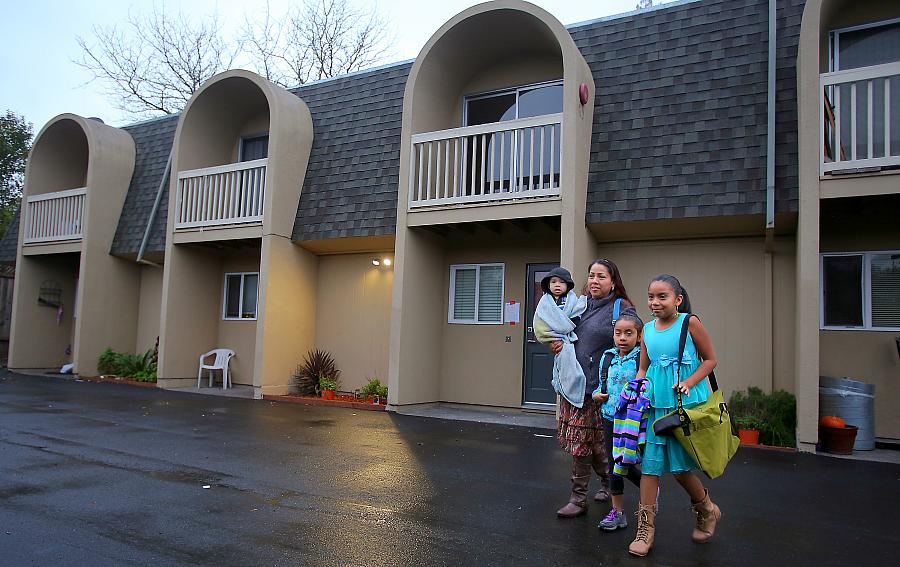Substandard housing in Sonoma County leads to poor health outcomes

Elizabeth Nolasco walks with her children, Sebastian, 1, Nicole, 6, and Jennifer Sanchez, 8, as they leave their Hoen Avenue apartment for school, in Santa Rosa on Friday, January 16, 2015. (Christopher Chung, The Press Democrat)
Nine Sonoma County families were forced to leave their Santa Rosa apartment building in January, more than a year after tenants from each of the units filed complaints with Santa Rosa code enforcement officials.
The city's order to vacate was prompted by the residents, who stopped paying rent in December, as a way to get the property's owners to fix the problems. Code enforcement records show that the families have been living with high levels of mold, cockroach and rat infestations, shoddy plumbing and inadequate heating, for years.
According to dozens of interviews with housing rights lawyers, code enforcement officials and building inspectors, these conditions are rampant in Sonoma County's poorest neighborhoods. Landlords face little consequences for letting their properties fall into disrepair. Residents, who say they are afraid to complain, simply wipe mold from walls, and live with cockroach and rat infestations. The problems exascerbate health complications amongst residents, including asthma, which according to the Centers for Disease Control and Prevention, is linked to mold and rat urine.
At least five of the residents of the Santa Rosa apartment building report having asthma, and note that it's grown worse since living in the hazardous conditions. They only came forward to complain after receiving free advice and help from two Sonoma County lawyers who specialize in tenant protections and habitability. Most often, people simply say nothing.
Sonoma County does not have tenant protections that people in other counties like San Francisco and Alameda have. Here, the county lacks just-cause eviction laws, which means landlords can evict people and don't have to give a reason. That has led to what one lawyer called a culture of retaliation here.
Tenants who complain are routinely given 30 or 60-day eviction notices. That has led to a chilling effect. Poor people don't complain because they are afraid they will be evicted for no reason, and are left with nowhere else to go.
Low income and undocumented people are disproportionately impacted by the lack of code enforcement by cities and the county, as well as the absence of tenant protections. I've talked to the county's top two lawyers who go after bad landlords, and they told me they receive calls daily from people afraid to report mold and infestations that lead to asthma and other outcomes that threaten public health.
Making matters worse, Sonoma County's housing crisis -- with skyrocketing rents and a one percent rental vacancy rate -- has squeezed poor families even further into poverty. Often, people simply live in squalor because there is nowhere else to move, according to preliminary interviews.
The county's leading expert on suing slumlords, who practiced in Los Angeles for most of her life and who also is advising some cities in the county on creating stronger tenant protections, recently gave the county as a whole a D- grade on how it handles poor conditions. She says there are incentives to not report, and people who do are at risk of becoming homeless.
Comparisons between county socioeconomic data and health outcomes by census tract show significant disparities in low-income neighborhoods, including Roseland — where the median earnings in 2013 was $21,883 and life expectancy topped out at 77 years. Compare that to Bennett Valley, six miles east of Roseland, where median earnings was $69,000 last year and life expectancy was 82 years.
Other neighborhoods in Sonoma County mirror those trends. My reporting will illuminate that divide, and show health outcomes are worse for low income people in those neighborhoods -- some at least directly correlate to poor housing conditions, where mold and cockroach infestations are rampant, according to sources.
Through this fellowship, I will investigate these issues, anazlyzing public policies in the county and each of Sonoma County's nine cities that have allowed bad landlords to continue operating. I'll continue reporting the story using health, housing, income and demographic data. My hope is to document challenges people who live in substandard housing conditions face.

